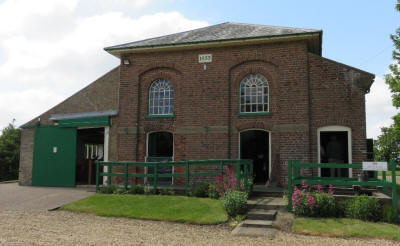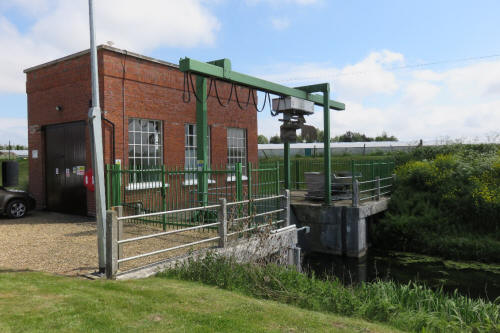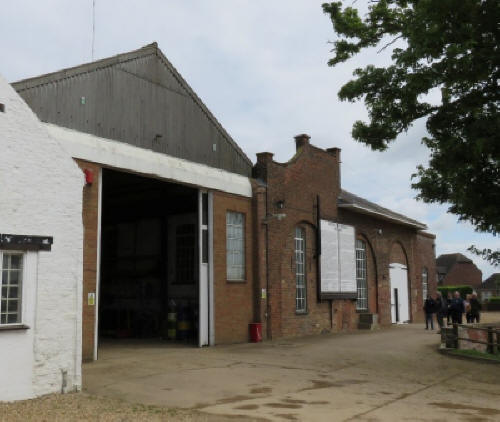|
   |
|
Page 4 |
Newsletter 126 Autumn 2019 © Hampshire Mills Group |
|
Drainage Engines of Spalding, May 2019
Eleanor Yates
Photos by Ruth Andrews
|
HMG’s study tour of Lincolnshire included a visit to
Pinchbeck Drainage Engine and Land Drainage Museum
near Spalding. A lovely site with birds and other
wildlife.
The drainage of Lincolnshire Fens and Marshes is
divided into sections, with each area having its own
system of engines and cuts. We were glad to read
that the section that was flooded in 2019 was not
the one that we visited.
Although we knew about the Dutch engineers working
in East Anglia in the 17th century we discovered
that the Romans built a bank round what is now
Lincolnshire to keep the sea off the land. Later
the land was given to monks and each monastic
foundation had its own abbey and associated
buildings built on the highest ground in the area.
In 852 the Land Book of Peterborough Abbey records
work being done on the Old Fen Dyke. Later we read
of donations of marshland given to new abbeys, dykes
and drainage ditches being cut and salt-pans being
created in the salt marshes. In 1297 the whole of
Holland in Lincolnshire was flooded. Maintenance
was also interrupted by the Black Death, the Wars of
the Roses, and the dissolution of the monasteries.
Not until the end of Elizabeth I's reign was the
General Drainage Act passed in parliament and Dutch
engineers started to widen rivers and build new
dykes and windmills to pump water off the land.
|

The
Pinchbeck Engine
is a restored beam engine, built in 1833 by the
Butterley Company of Ripley, Derbyshire, an
impressive reminder of the time when man relied on
the power of steam to drain the land. |
 |
|
It is a 20hp A-frame low pressure condensing beam
engine with a single cylinder of 35in (89cm) bore
and 56in (1.42m) stroke. The flywheel is an
impressive 18ft 6in (5.64m) in diameter. The engine
ran at up to 30rpm. Each year the Pinchbeck Pumping
Engine lifted an average of 3 million tons of water
from the land. The engine is gear-coupled to a
single scoop wheel in an adjacent compartment.
There are 40 paddles around the circumference of
the 22ft (6.71m) scoop wheel, which could lift a
maximum of 7500 gallons (34,000 litres) of water per
minute through an 8ft (2.44m) lift. The engine is
said to be the earliest A-frame engine still in situ,
the longest-working beam engine in the Fens, and the
last in use.
The boiler dates from 1895 and is a twin furnace
Lancashire boiler, delivering steam at
12psi. It consumed around 1cwt of coal per hour.
Coal supplies were originally brought by barge, but
after the land was successfully drained a railway
line was laid from Spalding to Boston, and coal was
delivered to a nearby goods facility. It was then
transported on a very short
narrow gauge railway line in
colliery-style tubs. The motive power for this
appears to have been human. One of the tubs and a
metre or so of line is displayed at the museum. The
chimney has been demolished. The museum includes
the original blacksmith's forge.
|
|
As drainage technology progressed steam-powered
drainage engines were replaced with diesel engines,
and then with electric pumps. However, diesel
engines were never introduced at Pinchbeck.. The
engine has survived in such fantastic condition
because the new electric pumps installed in 1952
were located in a new building. |
 |
|
Following our visit to Pinchbeck we were given a
special, and unexpected, visit to Pode Hole Pumping
Station which is active, and therefore not generally
open to the public.
This pumping station was installed because the cill
at Vernatt's Sluice, where the drain discharges into
the River Welland above Spalding, was higher than
the cill of the precursor sluices at Pode Hole. The
fen drains could not naturally discharge into
Vernatt's Drain. The two engines at Pode Hole were
the first of the large scale pumping efforts, and an
encouragement to later schemes.
By 1815 it is believed that there were some 50
wind-powered pumps assisting with land drainage in
the fen, and in 1820 the need for steam power to
assist with the pumping at the Pode Hole site was
identified. John
Rennie was consulted in 1818, and he proposed
diverting the upper reaches of Vernatt's Drain from
the Welland to the River Witham to improve the fall.
It is unclear if this would have worked, but the
funds were not available and a later proposal for
steam engines at Pode Hole was interrupted by his
death. In the end an engineer called Benjamin Bevan
appointed by the drainage commissioners placed
orders for two beam engines from separate engineers,
Fenton and Murray of Leeds, and Butterley of Ripley.
The first was 60hp, the second 80hp. Butterley
supplied both scoop wheels. The engines started
work early in 1825, and continued in use until 1925.
A third steam engine was erected on the north bank
of Vernatt's drain to lift water from Pinchbeck
South Fen. This operated between the early 1830s
and the end of the century. The water from the
South Drain was tunnelled under Vernatt's drain to
the Pode Hole station. (The idea of a tunnel under
a river is not unique. Not far away at Bourne South
Fen
Gilbert Heathcote's tunnel
was built under the River Glen, and might have been
the inspiration for the system at Pode Hole.)
The beam engines were maintained in storage until
1952, but then scrapped. Diesel engines were
already in use across the fens when Pode Hole was
modernised in 1925. The current Ruston diesel
engines date from 1964 and vertical axis axial flow
Foster Gwynnes pumps are driven by David Brown
gearboxes. The second station alongside uses
electric pumps and was built in the 1960s. There is
much more detail about the pumping engines at Pode
Hole on the internet. |
|
 |
The original pumping station building is a major
feature in the village, and is still in use for
workshops and a small museum. The by-laws of the
original commissioners are prominently posted on the
outside.
The day of our visit we narrowly missed the
excitement of a very tall cherry picker being used
to check the aerial as all site workers need
reliable two way radios for contact when working in
dykes and cuts.
|
| |
|
| |
|
|
   |
|
|
